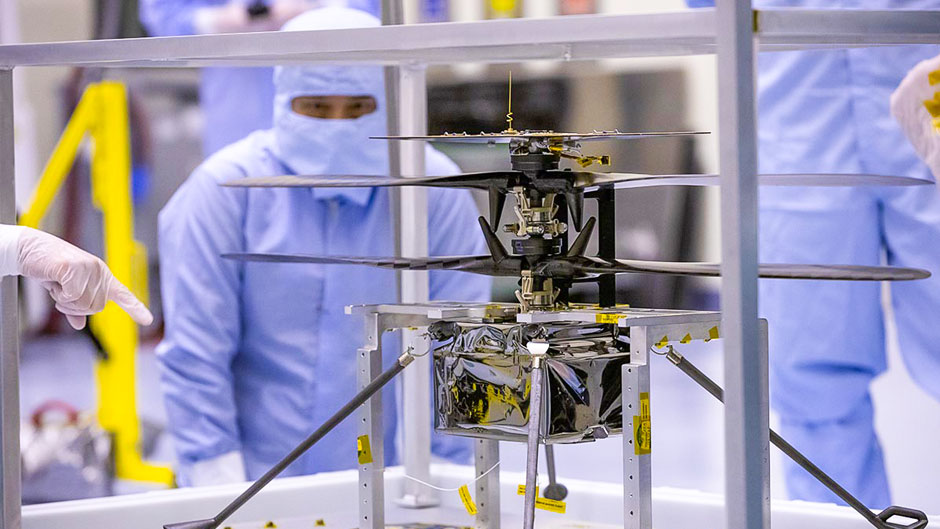This time, it flew faster and farther than it ever had.
Ingenuity, NASA’s experimental helicopter that hitched a ride to Mars aboard the Perseverance rover, completed its third flight on the red planet Sunday, reaching a speed of 4.5 miles per hour and traveling a little more than half the length of a football field.
The four-pound craft climbed 16 feet into the thin Martian atmosphere at 1:31 a.m. ET, as Perseverance watched safely from a distance and recorded the 80-second flight.
While the numbers seem paltry, the mission was nothing short of amazing, as it will pave the way for more sophisticated aerial scouting of Mars and worlds beyond, according to Lynn Holly Sargent, a Ph.D. candidate in mechanical and aerospace engineering at the College of Engineering.
“Advances in technology that are expensive and high risk-high reward, like the advances we are seeing from Ingenuity, should and usually are completed incrementally,” said Sargent. “If NASA can successfully prove that Ingenuity can fly in an environment completely different than what we are used to, that opens the door for a new wave of technology for space exploration.”
Sargent, who is conducting research on radiation shielding using magnetic fields for the surface of Mars, answers other questions about the Ingenuity helicopter, which she describes as an “important milestone for humanity.”
Why is NASA’s Jet Propulsion Laboratory team following such a methodical process in testing the helicopter?
Any well-devised plan where you are engineering something for the first time will often have a series of tollgates or milestones designed to ensure that there is a systematic approach to moving to the next phase of a project in order to reduce the risk of failure. The system components that make up Ingenuity were first extensively tested and validated at JPL (Jet Propulsion Laboratory) prior to sending the asset to Mars. Once the system was on Mars, there was a complicated deployment process that took place incrementally over a series of six solar days before the Perseverance rover cut ties to Ingenuity. Similar to this process, the teams are approaching the flight tests methodically, so if there are any issues that arise or if a preflight milestone is missed, the team can take time to understand the issue and correct as needed.
What is it about the Martian atmosphere that makes flying on the red planet so difficult?
Martian atmospheric conditions combined with dust, sandstorms, daily temperature differentials, and its distance from Earth all make autonomous flight and even technology survival itself very difficult on Mars and provide many avenues for potential mission failure.
Ingenuity’s maiden flight on Mars lasted only 40 seconds. The craft climbed 10 feet straight up, hovered, turned in place, and then landed. Why is such a short flight being described as a Wright Brothers moment?
You can’t run before you can crawl. The first flight, although short, is an example of another completed incremental milestone. Albeit completion of this milestone is considered the minimum success criteria of the mission and has a lot of historic implications.
Why is there such a fascination with Mars, and where would you like to be when a manned mission to the red planet is launched?
Mars exploration represents a longing to be a part of something that is outside of ourselves and outside of our world. It’s easy to be fascinated by Mars. More broadly, I think when you think about ranking civilizations and what they accomplished, what people knew about themselves and the universe around them is one metric that you would use to grade them. In terms of where I would like to be when we eventually send humans to the red planet, I don’t know if it will happen in my lifetime, although I hope it does. There are so many developments and further proof-of-concept missions that I believe would need to take place to safely support a human mission to Mars.
Another aspect of your research deals with system identification of swarms that use artificial intelligence to engage in cooperative pursuit. Could your research in that area possibly be applied to a rover or drone on Mars?
My research is heavily related to drone swarm technology and autonomy. I am fascinated by drones, control scheme implementation, and system dynamics. I have seen a lot of research being completed on autonomous swarms completing various tasks on Mars to support a base station. Autonomy is super important for drones on the surface of Mars, as we currently do not have the technology to fully control all aspects of motion in any near real-time capacity that would be needed to pilot a drone on Mars from Earth. I am excited to see how drone technology progresses in the aerospace arena and hopefully will continue to be lucky enough to work on some of the advances people are making.

